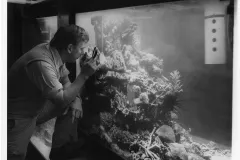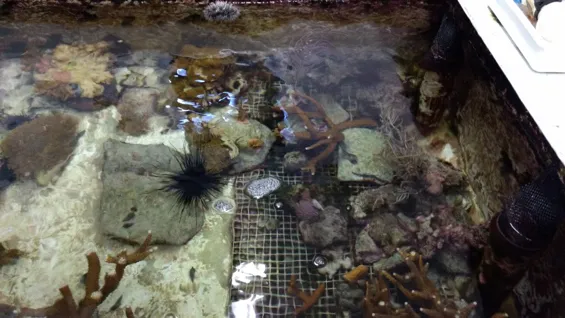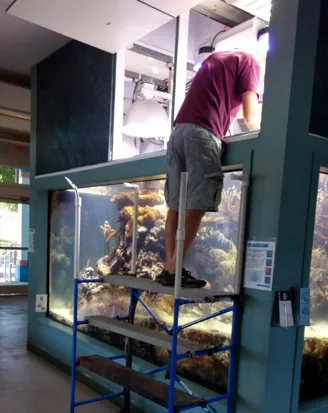The Evolution of a Reef Aquarium

In the late 1970s, Walter Adey, a paleobiologist and coral reef researcher at the National Museum of Natural History (NMNH), wanted to build a tank that would make it possible to monitor and experiment on a coral reef ecosystem in the laboratory—what scientists call a microcosm.
The first challenge he encountered was building a tank that successfully simulated natural processes. To mimic nature as closely as possible, Adey invented an Algal Turf Scrubber (ATS). In an open reef system, corals rely on a delicate balance of water chemistry; this balance is maintained through the actions of members of the ecosystem—especially corals, plankton, and what Adey named ‘algal turfs’—dense, low lying algal communities that take up the byproducts of other reef species (especially nitrites and carbon dioxide) and produce oxygen. Most aquarists at the time used a variety of filters to keep remove nitrites and small particles, including algae. However, Adey felt that these filters depleted oxygen and plankton (both required for coral growth) and let a lot of undesirable material pass through. Adey’s ATS instead harnessed the energy of algae by placing a large screen covered in algae above the tank. The water from the tank was continuously pushed over the algae, and as the algae grew it filtered excess waste materials from the water, added oxygen, and maintained a healthier level of plankton in the tank.
After success with a smaller laboratory tank, Adey unveiled a 3000-gallon Caribbean coral tank at NMNH in 1980. This tank was the first multispecies experimental coral microcosm in the world. Adey hoped that the use of microcosm reefs would result in studies of coral in the laboratory and the ability to understand—via controlled experimentation with his system—the impact of separate variables on coral health.
While visitors enjoyed the tank, which was displayed amongst the regular museum exhibits, they often mistook the murky water for a poorly kept aquarium. But by the early 1990s, the tank had been refurbished and new signs and training of volunteers helped educate the public about the importance of the system. Eventually, however, the cost of upkeep and the dual nature of the display—it functioned as both a live display and a place for scientific modeling and experimentation (which didn’t mimic anything in the museum at that time)—led the museum to find a new space for the tank.
That new space is in Fort Pierce, Florida at the St. Lucie County Aquarium, where it remains on display today. In 2001, the tank, including many of the original corals and the ATS system, was moved into the facility built across the street from the Ft. Pierce Smithsonian Marine Station. With the move, the tank underwent small, but important, changes. While the ATS maintained corals, Bill Hoffman, the director of the Aquarium, and his staff in St. Lucie have found that additional chemicals and nutrients are required to help coral thrive in the system. The additional nutrients have resulted in a healthier tank and increased growth for a variety of species.
With its location change, the tank’s purpose has also shifted. Instead of an experimental system, the tank is now largely used to educate visitors about coral reefs and the perils that they currently face. But the tank still offers value to the scientific community, especially as researchers and environmentalists work to save coral in the wild by breeding it in captivity.
Hoffman has been incredibly successful in maintaining many species, including staghorn coral. Staghorn are listed as Critically Endangered by the IUCN so learning how to maintain and breed them in captivity is important for their survival. The St. Lucie Aquarium has had success growing staghorn and sends fragments to aquariums throughout the U.S. While breeding staghorn in captivity has proven difficult, the specimens successfully spawned in the St. Lucie Aquarium tank in the summer of 2017, showing that this system can still offer much to those hoping to understand coral systems both in captivity and in the wild.
While Adey’s goal of his tank functioning as an experimental microcosm has been largely replaced by educational goals, the tank is still incredibly important to coral science and has inspired the creation of microcosms around the world.



